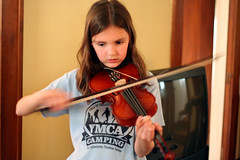Emilie Buesing handout for Situated and Social Learning Theories
Situated and Social Learning Theories
Description of Learning Theories
*Situated Learning theory is the idea that a person learns in a particular setting and by doing an actual activity.
*Social Learning theory is the concept that you copy what someone else is doing or has done. Essentially it is "follow the leader."
Similarities in theories
*In both theories, what you learn can be applied to the real world.
*Many of the learning activities are not found in textbooks, but are found in actual situations and while interacting with others.
*Many times students (or adults) do not even realize that these two forms of learning can be part of instructional design. They just assume that people 'just know that,' not that they could be taught.
Differences in theories
The two theories are very similar as they both teach skills used in the real world and are taught in real life settings, however social learning theory requires that other people are involved in your learning. You learn from the successes or mistakes of someone else.
Why Use this Theory?
Situated Learning Theory
| positives | negatives |
|---|---|
| real world learning | hard to use in a classroom |
| helps to promote self discovery | difficult to grade |
Social Learning Theory
| positives | negatives |
|---|---|
| promotes positive social interaction | needs a leader to follow |
| promotes positive peer relationships in the future | difficult to grade |
| learn by the example of others |
Example of Application
Lesh and Zawojeski suggested in Anderson, J., Reder, L., & Simon, H. (1996) that learning should take place in complex, social situations. A perfect example of social, situated learning would be a violinist in a school orchestra. If a violinist only practiced by herself she could learn how to play and be successful, but the complex skills that are needed to play in an orchestra would not be attained. The violinist needs to participate with the orchestra and have the situated and social learning experience to be successful.
young violinist practicing alone - not social, not situated
young violinist as part of a student orchestra, situated and social learning at work
References
Anderson, J., Reder, L., & Simon, H. (1996). Situated learning and education. Educational Researcher, 25(4), 5-11. Retrieved from http://people.ucsc.edu/~gwells/Files/Courses_Folder/ED%20261%20Papers/Anderson,%20Reder_Pt1.pdf
Brown, J., Collins, A., & Duguid, P. (1989). Situated cognition and the culture of learning. Educational Researcher, 18(1), 32-42. Retrieved from http://people.ucsc.edu/~gwells/Files/Courses_Folder/ED%20261%20Papers/Situated%20Cognition.pdf
Dong Hwa, C., & Juhu, K. (2003). Practicing social skills training for young children with low peer acceptance: A cognitive-social learning model. Early Childhood Education Journal, 31(1), 41. Retrieved from http://search.ebscohost.com.libproxy.stcloudstate.edu/login.aspx?direct=true&db=aph&AN=10588003&site=ehost-live
Macleod, M. (2010). The learning game: why imitation works. New Scientist, 206(2758), 40-43. Retrieved from http://search.ebscohost.com.libproxy.stcloudstate.edu/login.aspx?direct=true&db=aph&AN=50425321&site=ehost-live
Zielinska, I., & Chambers, B. (1995). Using group viewing of television to teach preschool children social skills. Journal of Educational Television, 21(2), 85. Retrieved from http://search.ebscohost.com.libproxy.stcloudstate.edu/login.aspx?direct=true&db=aph&AN=9510294371&site=ehost-live
[[<iframe src="http://docs.google.com/present/embed?id=dgdgpf79_16djmszvhj&autoStart=true" frameborder="0" width="410" height="342"></iframe>]]
Insert any HTML code, including widgets and video or audio players
[[/html]]







